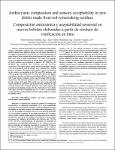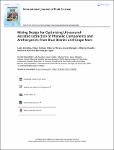Mostrar el registro sencillo del ítem
Thermal stability of anthocyanins in grape skin extracts from red winemaking residues
| dc.contributor.author | Merino-Miñano, María Fernanda | |
| dc.contributor.author | Luján-Herrera, Gladys Esmeralda | |
| dc.contributor.author | Vejarano, Ricardo | |
| dc.date.accessioned | 2021-07-12T23:58:23Z | |
| dc.date.available | 2021-07-12T23:58:23Z | |
| dc.date.issued | 2021-06-15 | |
| dc.identifier.citation | Merina, M., Luján, G., & Vejarano, R. (2021). Thermal stability of anthocyanins in grape skin extracts from red winemaking residues. Proceedings of the 6th Brazilian Technology Symposium. Smart Innovation, Systems and Technologies, 233(81), 740-749. https://doi.org/10.1007/978-3-030-75680-2_82 | es_PE |
| dc.identifier.uri | https://hdl.handle.net/11537/27170 | |
| dc.description | El texto completo de este trabajo no está disponible en el Repositorio Académico UPN por restricciones de la casa editorial donde ha sido publicado. | es_PE |
| dc.description.abstract | ABSTRACT The stability of anthocyanins in extracts from red grape skins after applying dehydration temperatures of 40 °C and 150 °C was evaluated. Two fractions of red grape skins: unfermented fresh grape skins (F) and skins from grapes after winemaking (V) were used. Extracts of both types of grape skins were prepared, and the total content of anthocyanins (by high-resolution liquid chromatography) and antioxidant capacity and color parameters (by UV‐vis spectrophotometry) were measured. Anthocyanins in extracts from grape skins dehydrated at 40 °C (F40 and V40) were more stable, with a total content of anthocyanins of 99.86 and 63.45 mg L−1, respectively. Besides, the extracts of grape skins F40 showed the highest antioxidant capacity (AC), obtaining 100% of inhibition of the radical DPPH with 1.0 g of these skins; meanwhile, the same amount of the other grape skins showed a percentage of inhibition lower than 46.01%. According to the color analysis, the extracts F40 and V40 showed the highest values of color intensity (CI of 1.21 and 0.57, respectively), as well as the highest percentage of red color (56% and 60%, respectively). In contrast, the extracts F150 and V150 showed the highest percentage of yellow color (76% and 51%, respectively), indicating a thermal degradation of anthocyanins to their colorless forms. According to the results, a greater stability at high temperatures was obtained in the fermented grape skins, which would be related to the synthesis of the most stable anthocyanin derivatives during the fermentative process. | es_PE |
| dc.format | application/pdf | es_PE |
| dc.language.iso | eng | es_PE |
| dc.publisher | Springer | es_PE |
| dc.rights | info:eu-repo/semantics/openAccess | es_PE |
| dc.rights | Atribución-NoComercial-CompartirIgual 3.0 Estados Unidos de América | * |
| dc.rights.uri | https://creativecommons.org/licenses/by-nc-sa/3.0/us/ | * |
| dc.source | Universidad Privada del Norte | es_PE |
| dc.source | Repositorio Institucional - UPN | es_PE |
| dc.subject | Antioxidantes | es_PE |
| dc.subject | Residuos | es_PE |
| dc.subject | Uvas | es_PE |
| dc.subject | Vinos | es_PE |
| dc.title | Thermal stability of anthocyanins in grape skin extracts from red winemaking residues | es_PE |
| dc.type | info:eu-repo/semantics/conferenceObject | es_PE |
| dc.publisher.country | CH | es_PE |
| dc.identifier.journal | Proceedings of the 6th Brazilian Technology Symposium | es_PE |
| dc.subject.ocde | https://purl.org/pe-repo/ocde/ford#2.11.00 | es_PE |
| dc.description.sede | Trujillo San Isidro | es_PE |
| dc.identifier.doi | https://doi.org/10.1007/978-3-030-75680-2_82 |
Ficheros en el ítem
| Ficheros | Tamaño | Formato | Ver |
|---|---|---|---|
|
No hay ficheros asociados a este ítem. |
|||





